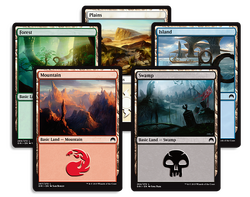Shock land: Difference between revisions
No edit summary |
(Changed order of lands to have the mana colours be sequential) |
||
| Line 19: | Line 19: | ||
| | | | ||
*<c>Godless Shrine</c> ({{W}}/{{B}}) | *<c>Godless Shrine</c> ({{W}}/{{B}}) | ||
*<c>Overgrown Tomb</c> ({{B}}/{{G}}) | |||
*<c>Breeding Pool</c> ({{G}}/{{U}}) | |||
*<c>Steam Vents</c> ({{U}}/{{R}}) | *<c>Steam Vents</c> ({{U}}/{{R}}) | ||
*<c>Sacred Foundry</c> ({{R}}/{{W}}) | *<c>Sacred Foundry</c> ({{R}}/{{W}}) | ||
|} | |} | ||
{{flexbox-footer}} | {{flexbox-footer}} | ||
Revision as of 18:06, 16 April 2022
The shock lands are a 10-card cycle of dual lands that were introduced in the Ravnica block. They have been reprinted in the Return to Ravnica block[1][2][3][4] and the Guilds of Ravnica block.[5][6][7]
Description
Each of these rare nonbasic dual lands has two basic land types and a static replacement ability, from which these cards derive their collective nickname "shock lands", that causes each to enter the battlefield tapped unless its controller pays 2 life. The name "shock land" is a reference to the card Shock, though there are technical and sometimes significant differences between shock lands' life payment and Shock's damage.
Despite having generic names meant to be reprintable on any plane, shock lands were so strongly associated with Ravnica that each return set granted it a reprint, and Ravnica's popularity meant it was one of the first planes to have a second revisit, and so there was never a need to print them on other planes. Acknowledging this, the Secret Lair Drop Series: Dr. Lair's Secretorium Superdrop Culture Shock collection has ten other planes that fit each shock land.
Shock Lands
|
|
History
As shock lands, like the original dual lands, have basic land types, they were and are often used in combination with fetch lands, where available. Due to this, they form an integral part of most decks in the Modern format, whereas in Legacy the original duals take their place.
Stomping Ground in particular was much sought-after, since it and a Kird Ape in one's opening hand meant a first-turn 2/3 creature. Loam Lion can also be a first-turn 2/3 creature with Temple Garden. Wild Nacatl can be a first-turn 2/2 creature with Stomping Ground or Temple Garden. It also forms the backbone of the Scapeshift-Valakut, the Molten Pinnacle deck as a green source that counts for Valakut. While other typed dual lands have been printed (and are used), none match the speed of Stomping Ground.
As the format sped up and Humans overtook Zoo, blue-based Shocks became significantly more relevant with Island-dense payoffs like Mystic Sanctuary and Archmage's Charm joining Cryptic Command.
References
- ↑ Monty Ashley (September 24, 2012). "Shocklands, Then and Now". magicthegathering.com. Wizards of the Coast.
- ↑ Adam Styborski (September 25, 2012). "Tribute". magicthegathering.com. Wizards of the Coast.
- ↑ Monty Ashley (February 19, 2013). "Shocklands, Then and Now II". magicthegathering.com. Wizards of the Coast.
- ↑ Mark Rosewater (February 27, 2017). "Get Ready to Dual". magicthegathering.com. Wizards of the Coast.
- ↑ Mark Rosewater (September 17, 2018). "Guild to Order, Part 2". magicthegathering.com. Wizards of the Coast.
- ↑ Wizards of the Coast (September 20, 2018). "Guilds of Ravnica Release Notes". magicthegathering.com. Wizards of the Coast.
- ↑ Mark Rosewater (January 2, 2019). "Building Allegiances, Part 1". magicthegathering.com. Wizards of the Coast.
